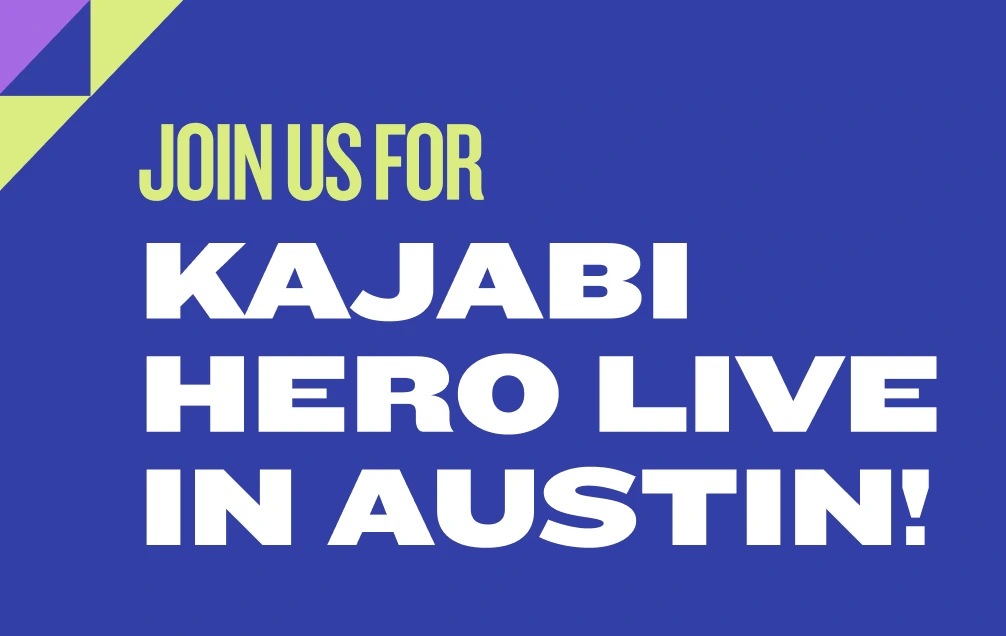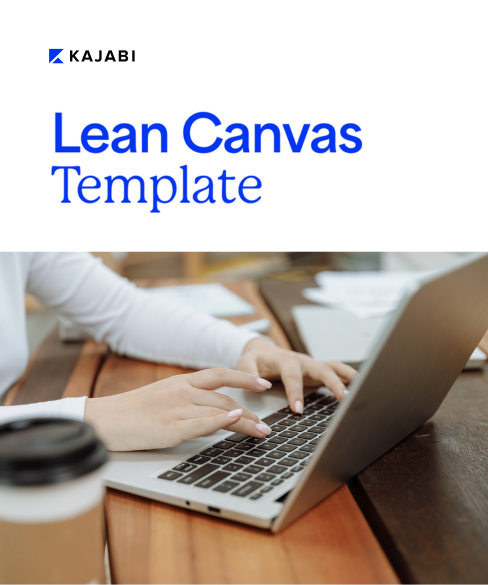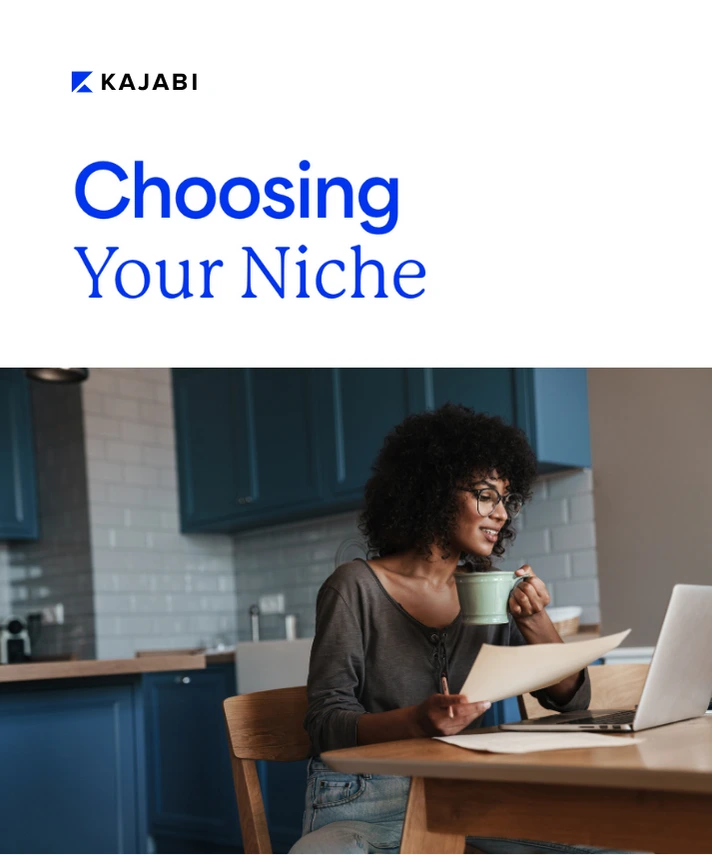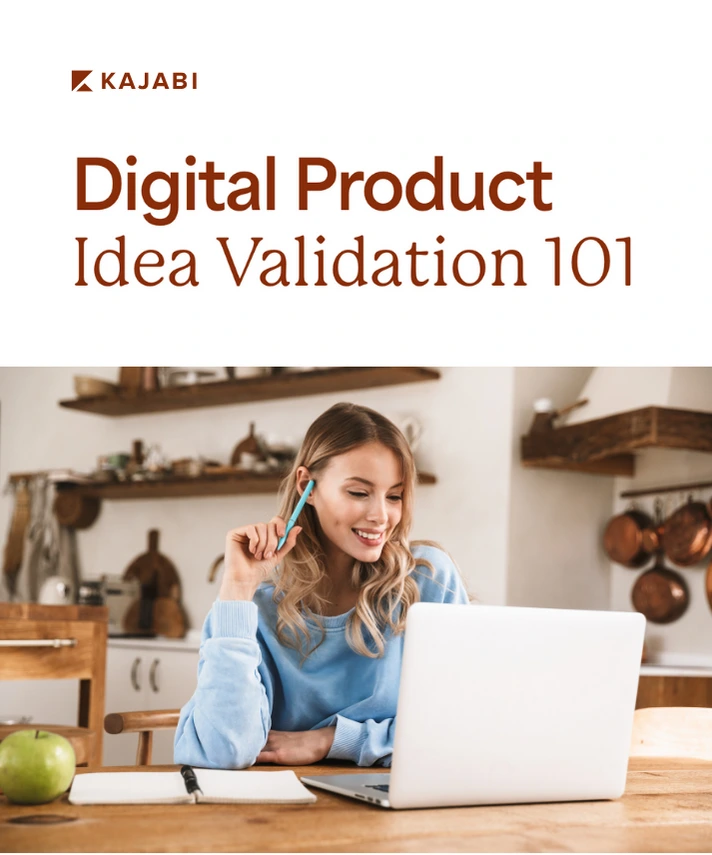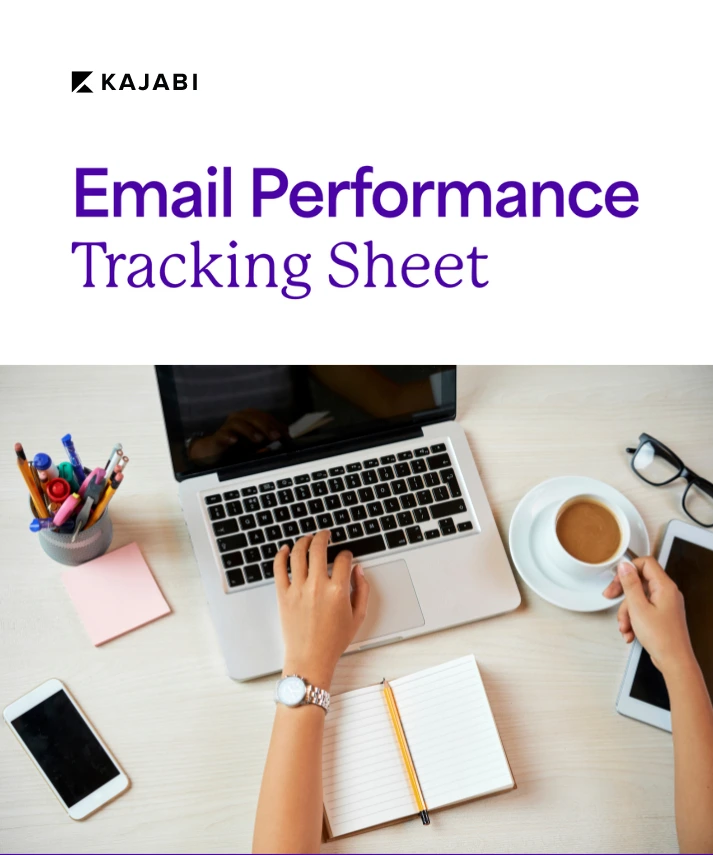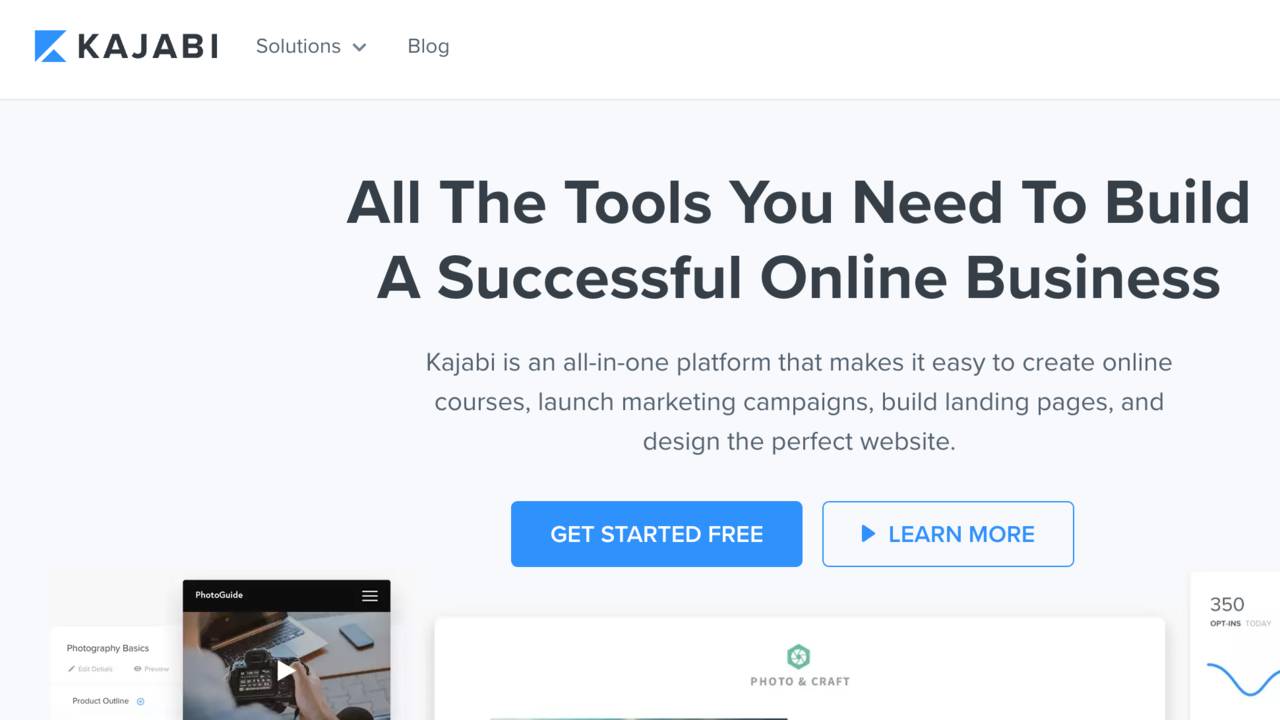
What is a Tagline & How to Write a Great Tagline For Your Business
Get free expert insights and tips to grow your knowledge business sent right to your inbox.
If you’ve ever visited the Kajabi homepage, you know we have a tagline: “You’re serious about your online business. We are too.”
It succinctly and clearly tells you what we’re about: helping entrepreneurs be wildly successful with their online businesses.
Let’s go over what a tagline is, why it’s important and how you can create an impactful tagline for your business.
{{find-niche}}
What is a tagline?

In business, a tagline is one or two phrases that provides clarity, entertainment, or emphasis to help highlight a brand's mission, purpose, or culture. Taglines help consumers feel more connected to brands.
You might have noticed that, in television commercials, taglines are repeated multiple times. The reason for that is to get those taglines stuck in your head. Here are a few popular taglines that you can likely instantly associate with the brand.
- Got Milk?
- Just Do It.
- I’m Lovin’ It.
- Maybe she’s born with it. Maybe it’s Maybelline
The last one also includes the brand name and that’s okay. You don’t have to be as large of a company as Nike to benefit from a tagline. A tagline can help you stand out from the crowd.
Your customers might remember your business because of your name or your company's name, but a tagline can make you even more memorable.
What is the difference between a tagline and a slogan?
Let's make a couple of distinctions so we don't get confused. Taglines sometimes get interchanged with slogans but these are two different types of marketing ploys.
A tagline applies to an entire business.
Let's say you have a photography online course business. Your business's name might be Mikaela’s Photography Lessons. Your tagline could be “Great Photos For Everyone.”
That tagline applies to any digital products that you create, wether you are selling online training courses or membership sites. You would also use that tagline on any marketing collateral that you create.
A slogan typically applies to a single product or branch of the business. Maybe you create online courses for both beginner and advanced photographers. In that case, you could create a slogan for your beginner courses like, "Get Your Lens Wet." A slogan for your advanced courses might look like this: "Take Your Photos To The Next Level."
The slogan only applies to the specific product or set of products that you developed it for.
What is the difference between a tagline and a logo?

A logo is typically a graphic mark that represents a business and makes it easily identifiable. You can see the Kajabi logo above.
It's our name in all capital, sans-serif type with a stylized letter K preceding it. You couldn't mistake our logo for our tagline because they are nothing alike.
Generally speaking, a logo is the business's name as well as some type of illustrative design. Some companies even use animated logos in some of their creative assets. Logos of all types exist, from incredibly simple ones like Google's to far more ornate and complicated designs.
Consider creating both a logo and a tagline. Your tagline doesn't need any special design element to make it stand out. However, you might want to hire a professional designer to create your logo.
{{find-niche}}
Why does your business need a tagline?

A tagline helps make your business more memorable by creating an impression. You want that impression to be as positive and uplifting as possible.
You can accomplish that by creating a tagline that encapsulates your business in just a few words. It's easier said than done.
Think of your online business as any other entity. You create products that you hope people will buy so that you can generate revenue and continue to sell your knowledge. A tagline allows you to extend your first impression beyond your logo and whatever content a consumer happens across.
What types of taglines exist?

You might have noticed that businesses develop taglines of varying lengths and content. Some are just one or two words, while others extend into one or two sentences.
There's no right way to develop a tagline. You need a tagline that represents your business and communicates to potential customers exactly what you offer.
Some taglines ask questions. They make people think. For example, the tagline, "Got Milk?" makes consumers think about milk. Importantly, it also makes people crave milk. This tagline establishes desire.
Other taglines make a concrete statement.
Disney's tagline, "The Happiest Place On Earth," communicates a clear idea. It tells people in no uncertain terms that Disney is the happiest place in the world.
Other taglines communicate a clear benefit. They tell the consumer what they can expect by patronizing the business.
Maxwell's tagline is, "Good to the last drop." It tells consumers that Maxwell coffee continues to satisfy until the mug is empty.
You can take inspiration from these types of taglines to create your own. In your own Knowledge Commerce business, focusing on benefits might be your best bet.
Since you teach a specific concept or topic, focus on letting consumers know what they can get out of your online courses and other digital products. How exactly will they benefit? What makes your digital products better than everyone else's?
How to develop a tagline: tips for making a memorable impression
If you're ready to create a tagline, let's go over some of the best practices for creating a memorable impression. The better your tagline, the more customers will remember you.
1. KISS
You might be familiar with the acronym, "Keep It Simple, Stupid Smarty." It's a good piece of advice for many different business ventures. Complex taglines are less memorable because they're more difficult to solidify in the mind.
Think about your most complex password for a website or software program. It's difficult for hackers and other criminals to gas because of its complexity. Yet, it's also more difficult for you to remember.
A password like your dog's name or the name of the first street lived on sticks in your brain because it's memorable and simple. A password like "X4!gT<1*" isn't memorable at all, which makes it more safe.
Your tagline doesn't need to be safe. It needs to be memorable.
Focus on keeping your messaging and your words as simple as possible. Don't use a long word when a short one will do. Similarly, get your message across in as few words as possible.
2. Less “mad men,” more meaning
Back in the days of advertising's glory, men and women sat in conference rooms and brainstormed clever, often meaningless taglines to impress their clients. Those days of advertising are over.
Don't channel "Mad Men" when developing your tagline. You don't need the Draper touch.
Instead, you need a tagline that people will understand as soon as they read it. Consumers don't like to have to puzzle over a tagline to understand its meaning. They want you to get to the point as quickly as possible.
A generic tagline can apply to any business. Consider a tagline like "Made For You." What type of business might this tagline belong to?
It could be a Knowledge Commerce business, a toy manufacturer, a brand of toilet paper, or a line of furniture. It's completely generic.
Avoid a generic tagline if you want to make an impression on your prospective customers. Create a tagline that can only apply to the type of business you run.
3. Storytelling at its finest
The best taglines tell a story. One of the finest examples of this type of tagline comes from Verizon Wireless: “Can You Hear Me Now?” It was often illustrated in commercials with a man walking across an entire city with a phone tacked to his ear, constantly asking, “Can you hear me now?”
Why did this tagline resonate? Because everyone could relate to it. These days, smartphone signals seem imminently reliable but that wasn’t true even five or six years ago. Dead zones happened everywhere and people constantly found themselves moving a few feet and asking, “Okay, how about now?”
It also told a story: the story of people everywhere who simply wanted to make a call and hear what the other person was saying. It simultaneously communicated a problem and a solution.
You can see another form of storytelling in Timex’s timeless tagline: “It Takes a Lickin’ and Keeps on Tickin’.” The story is clear here, as well. Timex wants consumers to know that dropping their watch on the floor won’t necessitate a new purchase.
It says, in a memorable way, that Timex watches are durable and reliable.
4. Bring on the benefits
Consumers are swayed by benefits, not features. They probably don’t care that a watch has fewer moving parts or that its face is made of some space-age material. Instead, they care that the internal workings will continue to last for years to come and that the face won’t crack if you drop it on the sidewalk.
That’s why you should focus your taglines on the benefits of your business.
M&M’s famous tagline does this well: “It melts in your mouth, not in your hand.” There’s a clear benefit here. You can eat M&M’s right out of your palm without smearing chocolate all over your skin.
That’s a simple benefit, but it works.
Wheaties did something similar with its tagline, “Breakfast of Champions.” With this tagline, the cereal company said its product would help turn the consumer into a champion through its nutritional content.
You can do the same for your online business. What benefits can your customers expect to receive after buying your digital products? How will their lives become better, easier, or more efficient?
5. Make your taglines clear
Murkiness doesn’t benefit taglines. If you weigh down your tagline with too many details, you’ll confuse the consumer and dilute your message.
Always seek to clarify your message. Don’t use words that could mean something else. Avoid saying something so obscure that prospective customers will wonder what exactly you’re trying to say.
Consider Prego’s tagline, “Prego … It’s in There.” This tagline worked for television commercials because actors could illustrate it on the screen. But when you simply hear the words, you’re not sure what they mean. This is especially true if you don’t know what Prego is.
The commercial referred to the fact that Prego spaghetti sauce contained all the delicious ingredients that would go into a homemade sauce.
For your Knowledge Commerce business, you don’t want to muddy the waters. Focus on creating a tagline that consumers can understand the second they read or hear it.
7UP did this well with one of its taglines, “The Uncola.” It’s simple, clear, direct, and unmistakable.
6. What’s your Why?
You might have heard Simon Sinek’s famous TED talk about finding your business’ Why. It's an important process for every entrepreneur because you need to know why you are in business and what drives you to succeed.
Digital entrepreneurs often find it easier to find their Why because they're driven by a specific mission. You may want to teach people a subject in which you are an expert, whether because you hope to help people or because you're passionate about the topic, or both.
Knowing your Why is important but if you can communicate it through your tagline, you'll have reached a rare form of marketing success. It's difficult to communicate your Why in very few words.
Wrigley’s accomplished this with the tagline, “Double Your Pleasure, Double Your Fun.” It communicates the benefits of its famous gum, of course, but it also illustrates the company’s Why.
Wrigley’s wanted to inspire pleasure and enjoyment with their product. It’s clear from the tagline that the company was interested in manufacturing a product that wouldn’t just bring great taste, but also pleasure.
7. Get people talking

Have you ever had a post go viral on Facebook? You get 10,000 Likes, even more shares, and the glow that comes with marketing success.
We like it when people talk about our businesses. While you certainly want customers to talk about your digital products, you can also inspire conversations in other ways.
A great tagline often does this well. Marketers might mention your tagline as an example of excellence, just as we’ve done several times with other businesses in this article. Consumers might share your tagline on Facebook, either because it’s funny or memorable, or both.
It’s not easy to achieve, but you can play with different linguistic concepts to help make your tagline more shareable.
For instance, rhyming is always pleasant to the ear. That’s why poetry has survived through hundreds of years. We already mentioned Timex’s tagline, “It’s Takes a Lickin’ and Keeps on Tickin’.” The rhyming words make it even more appealing.
Alliteration can also help. If most of the words in your tagline start with the same letter, the phrase becomes more memorable and the tagline more shareable.
Other options include:
- A play on words
- Onomatopoeia
- Homonyms
- Homophones.
Just make sure that you’re using these literary techniques on purpose. Accidentally substituting a word for its homonym might make your tagline shareable, but not in a good way.
{{find-niche}}
8. Less is more
Some of the shortest taglines in history are also the most popular. Remember “Do You … Yahoo?” It was a popular tagline because people repeated it as a joke and because it was short and sweet.
Less is always more when it comes to taglines and slogans. Campbell Soup is another great example: “Mmm, Mmm, Good.” Clear and simple, but unmistakable.
9. Google is your friend
The last thing you want to do is create a tagline that already exists. Not only will you infringe on another business’s intellectual property but you’ll also instantly brand your business as uncreative and unoriginal.
That’s not a good start for your digital business.
After you create a tagline, wrap it in quotes and Google it. You might find exact matches that aren’t taglines — don’t worry about those. You’re looking for businesses and websites that have used that tagline as their own.
Don’t panic if you find your tagline is being used. You can easily tweak it to make it more original. Change a few words or move the phrasing around. Get creative.
Also, this is a good excuse to brainstorm a few taglines that you love. Three is a good number to start with. You might like them all equally. Searching on Google could narrow down the choices based on what already exists.
Examples of impressive taglines

Let’s break down why some great taglines work. This might help you create one of your own.
Let’s start with Airbnb, a travel company. “Belong Anywhere” is one of Airbnb’s most famous taglines and it works for several reasons.
The idea behind this tagline creates a connection between the company purpose and its potential customers. People often feel adrift when they stay in cold, sterile hotel rooms that lack personality and the warmth of personal touches. Airbnb offers to help eliminate that problem by offering homes or local rooms to stay in.
“Belong Anywhere” promises consumers that they can feel right at home even when they’re traveling to another city or even across the world. They can stay in someone else’s home and enjoy all the creature comforts that come with such accommodations.

Then you have Coca-Cola, which has gone through many taglines over the years. One of its most famous was “Things Go Better With Coke.” This is a benefit tagline that tells consumers they can enjoy a carbonated beverage no matter what they like to eat or do.
You can take inspiration from this tagline by creating an inclusive tagline of your own. Showcase the benefits of your products and show why you’re the best.

The General Electric tagline suggests creativity and innovation: “We Bring Good Things to Life.” Based on this tagline, we can infer that GE takes great ideas and concepts and turns them into usable, dependable products.
You can use a tagline like this in Knowledge Commerce, too. You’re selling knowledge or digital products but you’re also selling the result of that knowledge.
Maybe you teach online courses on health and fitness. People can learn how to eat more nutritious meals, exercise safely, and build muscle while burning fat. But what are the results of that knowledge?
Improved health. More stamina. Greater strength. A toned body.
You can see how brainstorming will make your taglines come to life.

Now, let’s look at the Jared tagline: “He Went to Jared.” Most people have heard this phrase if they watch television or listen to the radio.
We’re looking at an emotional headline here. The idea suggests that everyone will congratulate you for going to Jared’s for jewelry. It’s designed to appeal to social proof without actually using any social proof, which is tough to pull off.

We’ve all heard MasterCard’s tagline, which has been used for countless Internet memes: “There are some things money can’t buy. For everything else, there’s MasterCard.”
This is one of the longer taglines, but it still works because it tells a compelling story. It acknowledges that some things are priceless, as you’ve likely seen in the commercials, but that you can depend on MasterCard for the things you need.
Taglines can help your business draw new customers
Do you need a tagline for your online business? Yes, if you want to set yourself apart from the competition. A memorable tagline can be worth considerable sales down the line.
Here are the tips for creating a great tagline:
- Make sure to keep your tagline simple. Inject meaning into every word
- Tell a story with your tagline
- Focus on the benefits of your business
- Clarify the “Why” of your business
- Look at great taglines as examples.
Use Kajabi to Turn Your Knowledge And Content Into Products You Can Sell
Ready to be your own boss? Ready to monetize your knowledge? You need Kajabi - It’s a full-featured platform that allows professionals like you to create their own businesses from home.
Create online courses, establish membership sites, offer coaching programs, host a podcast, and sell other digital products. Plus, you'll get marketing tools like a website, CRM, email marketing, landing page templates, and helpful analytics to help you spread the word about your products and earn more revenue.
Fully explore what Kajabi has to offer and start building your business during a free trial. Start your free 14-day trial of Kajabi today!
Still researching? Check out Kajabi’s free downloadable ebook guides on launching and growing a knowledge commerce online business!
{{find-niche}}
Find more blog posts by category:
Marketing
Kajabi Hero Stories
Create Your Product
Build Your Business
Grow Your Business
Kajabi News

